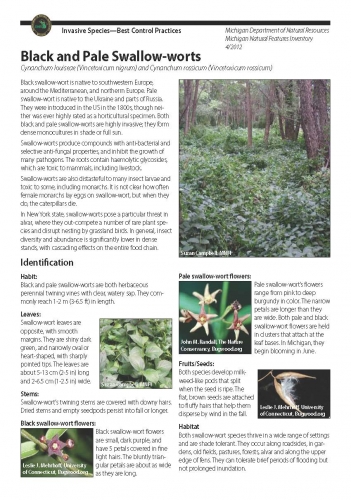Best Control Practice Guides available from Michigan Natural Features Inventory
Comprehensive resources are available to help those trying to combat some of Michigan’s nastiest invasive plants.
 The Michigan Natural Features Inventory (MNFI) is a program of Michigan State University (MSU) Extension. Part of MNFI’s mission is to actively contribute to decisions that impact the conservation of biological and ecological diversity by collecting, analyzing and communicating information about rare and declining plants and animals, and the array of natural communities and ecosystems native to Michigan. MNFI has joined together with the Michigan Department of Natural Resources Wildlife Division and State Park Stewardship staff to develop resource guides to help assess and control a number of Michigan’s invasive species.
The Michigan Natural Features Inventory (MNFI) is a program of Michigan State University (MSU) Extension. Part of MNFI’s mission is to actively contribute to decisions that impact the conservation of biological and ecological diversity by collecting, analyzing and communicating information about rare and declining plants and animals, and the array of natural communities and ecosystems native to Michigan. MNFI has joined together with the Michigan Department of Natural Resources Wildlife Division and State Park Stewardship staff to develop resource guides to help assess and control a number of Michigan’s invasive species.
Invasive species are the second biggest threat, with habitat destruction being the biggest threat, to Michigan’s native diversity. They have already had major impacts in nearly all of the state’s natural communities. To date, Best Control Practice Guides are available for Japanese barberry, oriental bittersweet, autumn olive, glossy buckthorn, Japanese knotweed, common buckthorn, black locust, and black and pale swallow-worts.
For each invasive species, the guide gives information about where the species originated, how it was introduced into the United States and its impacts on native plants. Color photos, along with detailed information about its habit, leaves, bark/stem, flowers, fruits/seeds and habitat help to positively identify each species. Where pertinent, similar species are also listed to aid in positive identification of these invasive plants, extensive information is given on reproduction/dispersal as well as an exhaustive list of appropriate mechanical and chemical control methods. A quick reference chart summarizes specific herbicides and application methods, including pros and cons for the use of each.
Constrained by limited budgets, state agencies must rely on trained volunteers such as MSU Extension Conservation Stewards and Master Gardeners, local communities, and conservation-minded groups to control invasive species. These Best Control Practice Guides, along with the supplemental resources given, serve as excellent tools that can be used to positively identify invasive species, and tailor control methods to specific situations and site conditions to achieve successful control.
To view the Best Control Practice Guides, visit the MSU Extension website.
For more information and resources on invasive species, including those in aquatic and wetland habitats, see this Invasive Species article.
For more information on MNFI including data, programs, services, and educational resources, visit the MNFI website.



 Print
Print Email
Email



